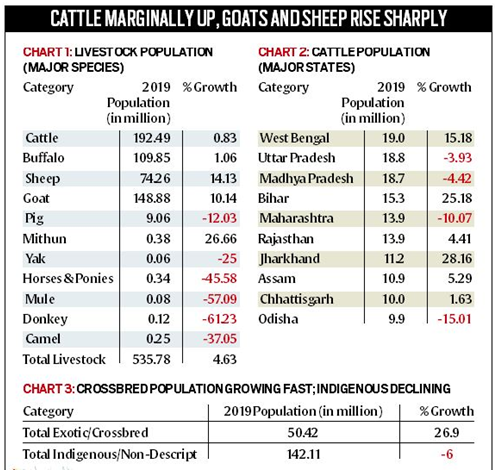

The Ministry of Fisheries, Animal Husbandry & Dairying has released the 20th livestock census.
Context
The Ministry of Fisheries, Animal Husbandry & Dairying has released the 20th livestock census.
About
- Livestock census provides headcount data of domesticated animals in the country.
- India has been conducting livestock censuses periodically since 1919-20.
- The last livestock census was conducted in 2012.
- India leads the world in livestock population.
- Various species of animals possessed by households, household enterprises or non-household enterprises and institutions (like cooperatives and religious places) were counted at site — both in rural and urban areas in this census.

- Animals and birds counted in livestock census include domesticated animals (cattle, buffalo, mithun, yak, sheep, goat, pig, horse, pony, rabbit and elephant) and poultry birds (fowl, duck, emu, turkeys, quail and other poultry birds).
- For the first time, livestock data has been collected online through tablet computers procured under NMBP Scheme.
Key Findings
- Indigenous cattle population is further In 2019, the total livestock population is 535.78 million; cattle (192.90 million) is the largest animal group in the country followed by goats (148.88 million), buffaloes (109.85 million), sheep (74.26 million) and pigs (9.06 million).
- West Bengal has emerged as the state with the largest number of cattle in 2019, followed by Uttar Pradesh, and Madhya Pradesh.
- Population of exotic /crossbred species numbers have gone up.
- West Bengal overtakes UP with largest cattle population
- Share of dairy animals in total number of milch cattle has gone down.
- Camel numbers are the lowest in Rajasthan in 7 decades.
- Population ranking of livestock population is as follows: Cattle >Goats >Buffaloes >Sheep >Pigs > Other (All other animals taken together contribute just 0.23 per cent of the total livestock population in the country).
What are the implications?
- Due to continuous fall in productivity, indigenous breeds of cattle have become liabilities.
- Farmers find other animals such as buffaloes, goats and sheep more productive. Unlike cows, if they become unproductive, they can be sold and slaughtered for further processing.
- Fall in indigenous breeds can have long term health and environmental impact; because the milk of indigenous breed has higher nutritional value than that of crossbreeds.
- There is a danger of losing these indigenous breeds.
- Decrease in cattle population in Uttar Pradesh comes despite several steps taken by the state.
- Some increase in cattle population owes to the ban on cattle slaughter, which could have led to increase in cattle owners abandoning unproductive animals.
- This has caused disruption in cattle economy which may adversely impact farm incomes

